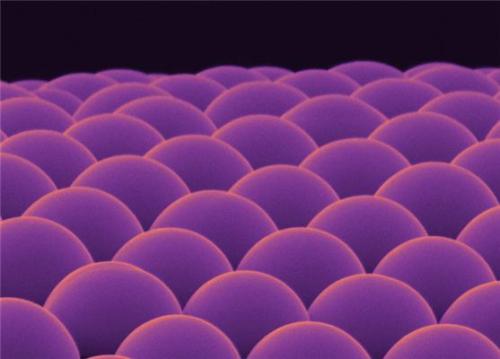A team of researchers at the Max Planck Institute of Colloids and Interfaces, together with multiple university partners, developed a simple synthesis process for microlens arrays, unique micro-optical devices.
 Microlens arrays made from calcium carbonate © Kyubock Lee / MPI of Colloids and Interfaces
Microlens arrays made from calcium carbonate © Kyubock Lee / MPI of Colloids and Interfaces
The partners of Max for this initiative include the KAIST in South Korea, University of Konstanz, and the Korea Institute of Geoscience and Mineral Resources. The scientists used saturated calcium solution and CO2 in air, which following mineral precipitation resulted in the synthesis of hemispherical, micro-optical CaCO3 structures. The organic surfactant acted as regulatory elements.
Biominerals grow in aqueous media, in a genetically programmed series, at ambient conditions. The researchers revealed the rapid production of CaCO3 structures with micron sizes on the surface of Ca saturated solution in atmospheric condition. In less than 2 h, a thin film is observed. Supplementing the growth media with organic surfactants enabled the synthesis of hemispherical- shaped and uniform-sized structures.
Multiple images of a µ-sized 'A' have been observed through the array of microlenses. The collimated light can be focused into1 µm spot by passing through 6 µm CaCO3 microlenses with focal length ranges 7 - 8 µm.
This biocompatible CaCO3 is included in the skeletons of a large number of biological organisms, where they act as substrates. The biocompatibility of the CaCO3 microlens arrays can be determined by seeding fibroblasts, the common cells present in the connective tissue of animals. It also helps determine the viability of the cells on the array. Among the array, a single cell can cover multiple microlenses. This phenomenon represents that CaCO3 microlens arrays combined with optics can be effectively used for cell biology research and analysis.